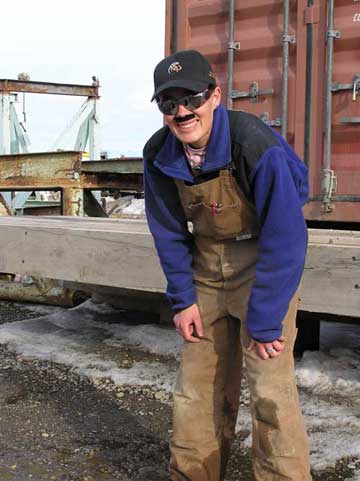 By Ned Rozell June 22, 2006
Backensto works in the oilfields on Alaska's North Slope. Her study subject is ravens, and she has taken to wearing a moustache because they seem to recognize her as she roams the industrial landscape. She now tries to fool them by posing as an oilfield worker and tucking her hair below a ballcap, wearing Carhartt overalls, and sticking on a moustache. "All of the adults I've tagged remember me," Backensto said. "It makes them hard to trap or get close to." Backensto, a Ph.D. student with the University of Alaska Fairbanks' Regional Resilience and Adaptation Program, is studying how the raven fits into the equation of how oil and gas development affects migratory birds. During her fieldwork, she spends much of her summer at oilfield camps near the Arctic Ocean. Workers there started noticing ravens as the only bird species during a Christmas Bird Count years ago, and now there can be more than 100 ravens in the dead of winter at Prudhoe Bay. "I think there were likely ravens on the North Slope (before oil development), but they weren't breeding with the density and distribution we're seeing now," she said. Though the landfills on the North Slope are clean because workers burn food and cover trash when they move it, ravens and other animals (glaucous gulls, grizzly bears, and arctic foxes) are there in good numbers because humans are there, Backensto said. Ravens scrounge human food in winter but go to natural sources when it gets warmer. They eat lemmings, shrews and the eggs of eiders, geese, and ducks. "They make good use of the tundra," Backensto said. "We're trying to understand their impact on tundra-nesting birds in summer." About 20 or 25 pairs of ravens nest in the oilfields on drilling rigs, communications towers, and other structures, often using strands of wire and plastic tie straps to build their nests. Those pairs have up to six chicks in what most birds would consider winter. "We had chicks in nests here at the end of April," Backensto said. "We were still having 10-to-15-below days here, and it's at least a week until the chicks have any feather development." Because breeding territory is limited in the oilfields, young ravens often leave the North Slope at the end of summer. Prudhoe Bay ravens Backensto has captured and fitted with vinyl wing tags have shown up in the village of Beaver on the Yukon River and in Fairbanks and Anchorage. "I think the (Dalton Highway) is an important travel route," she said. "There are potential scavenging options along the way." Now on her third year of spending most of April through August at oil camps on the North Slope, Backensto said oilfield workers she now impersonates while stalking ravens have helped her out. "The people that work up here are a fantastic source of info," she said. "A good portion of our study is rooted in talking to people up here, and they've really helped me try to trap ravens." Sometimes those workers have walked right by Backensto when she's wearing her moustache, which she bought at Party Palace in Fairbanks (she had to defend the expense to an accountant in the Institute of Arctic Biology business office). She's not sure yet if she's fooling the ravens. "It's too early in my fake moustache season to know if it's making a difference," she said.
Ned Rozell [nrozell@gi.alaska.edu] is a science writer at the institute. Publish A Letter on SitNews Read Letters/Opinions
|
||
